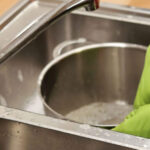
Dish Sponges Are Screwing Up The Environment. What Should You Use Instead?
- Thomas Nelson
- August 9, 2022
- Sustainable Living
- 0 Comments
When I wrote the title of this article, I had to stop and ask myself, what isn’t screwing up the environment these days? I was pretty surprised at just how bad sponges can be for the environment when I sat down to do the research for this article. I’ve probably bought hundreds of those yellow sponges with the green backing in my life without ever once really considering what they were made of and what kind of impact they have. I’m pretty sure there’s one sitting in my kitchen as I type.
What makes sponges so bad for the environment? They seem like a pretty innocuous thing, right? And what should you use instead of a sponge? In this article, we’re going to dive into these two questions and help you navigate the world of eco-friendlier dish cleaning options.
Store-bought sponges are an environmental shitstorm
Maybe ‘shitstorm’ is a strong word, but they’re definitely not great. If you peruse the cleaning aisle of your local market, the majority of the sponges you’ll see, and certainly the ones that cost the least, are made mostly or entirely of plastic. Every year in the U.S. alone, approximately 400 million sponges are sent to the landfill. Despite being made of plastic, these sponges cannot be recycled.
Additionally, in the same way that we try to avoid polyester clothing to prevent microplastics screwing up our water, these sponges also shed plastic fibers. So as you clean your dishes, little bits of plastic are washing down the drain.
Thankfully, plastic sponges aren’t the only dish cleaning products available to us. Frankly, they’re not the only sponges available! There are other, natural options. Bear in mind though that just because something is marketed as ‘natural’ doesn’t automatically make it ecologically sound. We need to do our research to get the full picture.
What about natural sea sponges?
You have probably seen natural sea sponges marketed as an eco-friendly alternative to the plastic sponges we’ve been talking about. There are natural, to be sure. They come right out of nature. Sea sponges are actually an animal that lives in the ocean and feeds on microscopic organisms they filter out of the water. Neat!
The sad part is, when the sponges are removed from the water, they die. Even after death, they retain their general physical structure, which is ideal for cleaning. But because the sea sponges are killed once harvested, they are an unacceptable alternative for vegans or people who err on the side of leading a plant-based lifestyle.
But there are some general pros to sea sponges, including that they are biodegradable, durable, absorbent, non-toxic, hypoallergenic, and renewable when harvested sustainably.
Does harvesting sea sponges hurt the environment?
So we’ve established that sea sponges are living animals that must be harvested from the ocean. Does that harvesting process damage the environment? Are we over-harvesting them? The answer is a bit complicated, but you can rest assured that you aren’t contributing to overharvesting if you purchase sea sponges marketed as sustainably harvested.
According to one report, sewage and scallop dredging do substantially more harm to the sea sponge than harvesting for household use. If you buy a sea sponge, the chances are high that you are doing less harm to the environment than you would be if you bought a plastic sponge. But are there other options out there for us?
What are the alternatives?
If you’re washing dishes by hand, the sponge isn’t your only option. Let’s go over a few of the alternatives.
Dishcloths
Dishcloths are a simple and common alternative to sponges, but be extra careful when selecting a dishcloth and ensure that it’s made from durable, natural, and sustainable materials. Some guidelines for purchasing any kind of cloth:
- Look for sustainable fabrics, like bamboo, recycled cotton, organic hemp, organic linen, or TENCEL lyocell
- Find brands that adhere to certifications like fair trade, GOTS, OEKO-TEX, C2C, RCS & FSC and place sustainability at the forefront of their business practices
- Avoid unsustainable, environmentally harmful fabrics like conventional cotton, polyester, nylon, rayon, and acrylic
Swedish dishcloths
First meatballs and Ikea, now dishcloths? The Swedes really nailed the dishcloth back in 1949 when a Swedish engineer developed the Swedish dishcloth. This cloth is usually made from about 70% wood pulp and 30% cotton. It’s extremely durable and completely biodegradable. They absorb about 15 times their weight in water and dry very quickly, which reduces the buildup of bacteria. These cloths can be washed around 200 times. As mentioned above, look for dishcloths that adhere to sustainable and environmentally friendly practices.
Natural brushes
Dish brushes are another option for cleaning your dishes, but avoid brushes that are made from plastic, like the ones commonly found in stores. Instead, look for natural cleaning brushes. Some guidelines for purchasing these brushes:
- Look for brushes made from sustainably sourced wood
- The bristles should be made of natural fibers like coconut, sisal from the agave plant, or bamboo
- Try to avoid plastic packaging
Read Next: 51,000 Trees Are Cut Down Every Day To Make Paper Towels. Let’s Break This Habit

